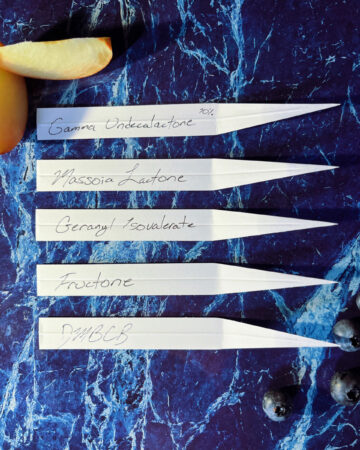
Fantasy Fruit Notes Mouillettes, For the Scent of It
When you think of fruit notes in perfumery, what comes to mind? Peach, coconut, plum? Like a bowl brimming with fruit on the table, there are so many delicious options in perfumery. Citruses are technically fruit, but we’ll be plunging our hands into the bowl that resides on a table in the realm of fantasy.
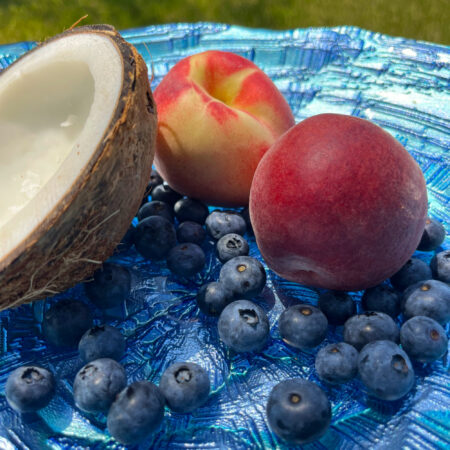
Fantasy Fruit Bowl, For the Scent of It
As far back as the early 20th century with the use of Peach Aldehyde (Gamma Undecalactone) contributing a juicy peach note to the chypre structure of Guerlain’s 1919 Mitsouko, fruits have been spilling their juices over the top and heart of many fragrance pyramids.
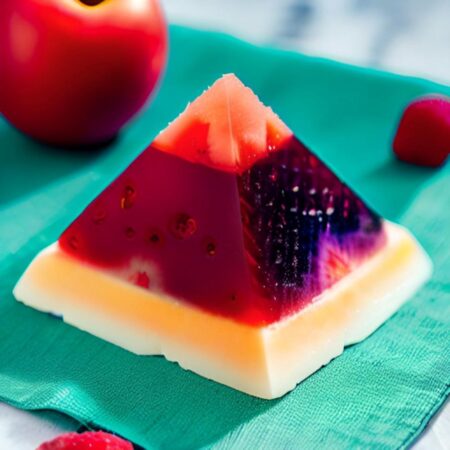
Fantasy Fruit Notes Pyramid, For the Scent of It
With the advances in chemistry through the decades, many new ingredients found their way to perfumers helping to not only create new fruity notes, but also shape modern perfumery as we know it. The explosive rise of fruity florals and gourmands during the 90’s and 2000’s allowed for fruits to step out of supporting roles and take the spotlight. Even natural perfumers have gained access to these fantasy fruit notes with the availability of natural isolates and CO2 extracts. Thank you, science and chemistry. To create an accurate fruit note takes a variety of materials that cover the gambit of olfactory profiles. What I’ll be discussing are those that have characteristic aromas to each fruit. So, let’s talk!
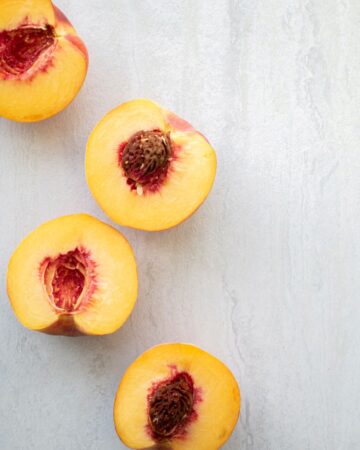
Fantasy Fruit Notes: Peaches, via unsplash
Let’s begin with the “crème de la jus” of fruit notes in perfumery: Peach. It can be mouthwateringly juicy or a creamy duvet. Peach has a way of not only enhancing top notes, but it also can be the foundation for other fruits and florals to rest. You’ll find this note at the top and heart of countless fragrances, florals especially. The nectar of the peach just blends so well with sheer, white florals like tuberose, orange blossom and jasmine. Many perfumes utilize only a handful of ingredients to create a peach aroma. Mainly, you’ll smell those with “decalactone” in its name somewhere, such as Gamma Undecalactone, Gamma Decalactone, Delta Decalactone, etc, etscentera. Some smell creamier than others, but all these just make a fragrance just peachy.
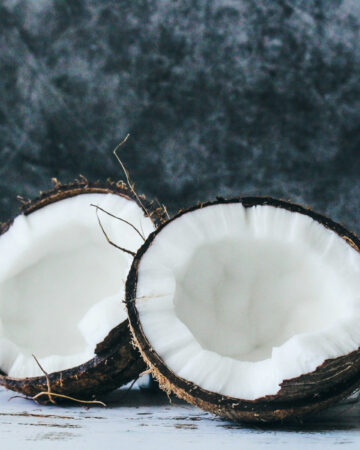
Fantasy Fruit Notes: Coconut Unsplash
Speaking of lactones, someone grab that coconut. We can all imagine the smell of coconut in fragrance. Whether it conjures images of suntan lotion or a tall piña colada, we’ve all smelled its sweet creaminess somewhere. You’ll often find a note of coconut alongside tuberose, vanilla or sandalwood since they all enhance each other’s smooth, creamy aspects. Coconut can soften harsher notes as well, smoothing citruses and creating a cozy cloud. Lactones are usually the path to coconut in fragrance. Aldehyde C18 (Gamma Nonalactone) and Gamma Octalactone for instance. There are new, natural ingredients such as Coconut CO2 extract that’s a fatty coconut aroma and the natural Massoia Lactone that, in my opinion, smells more like coconut than coconut does.
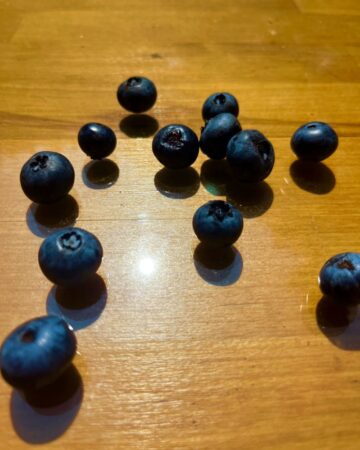
Fantasy Fruit Notes: Blueberries, For the Scent of It
Let’s reach for one of the dark fruits in the bowl, blueberry. Whether you enjoy them in your pancakes, muddled into a cocktail, or just love them on their own, it’s hard not to love blueberries. In fragrance, they’re able to bring on a dark fruitiness, pairing extremely well with woods, rose and other fruits. One of the most characteristic blueberry aromas that I personally have found comes from Geranyl Isovalerate. Like all red and dark fruits, other materials that prove useful are Fructone (IFF), Fructalate (Firmenich), Raspberry Ketone (very useful for berries in general) and other butyrates and acetates. You’ll find in perfumery, many of the same materials are used for many fruits, just in different proportions. Like molecules found in Nature. Many plants share the same molecules, just in very different proportions with some key variances that offer a unique olfactory profile.
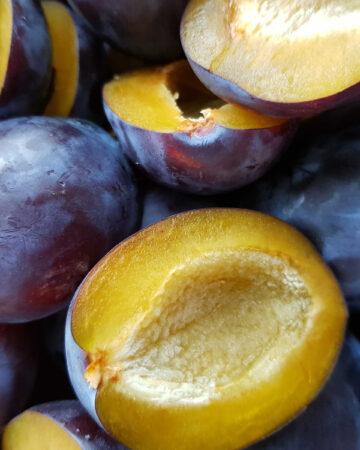
Fantasy Fruit Notes Plum Halves via Unsplash
Speaking of dark fruits, I think I see plum in the bowl! Who doesn’t love plum? Even if you don’t eat them, you most likely love them in fragrance. When it comes to plum in fragrance, there are two schools of thought. Is it fresh plum or dried plum, aka prunes? Fresh plums have a tart, green and sweet juiciness that’s all their own, while dried plums have a dark fruitiness paired with a dense, rosy-honey sweetness. Depending on if you want your plum tart and ripe or dried and sweet, there are a variety of ways. Dimethyl Benzyl Carbinyl Butyrate works well for both. The rose ketones, such as Beta Damascone, are used for a good juicy plum note in the top. They give that plum and rosy punch in the opening of many perfumes (think of the fruity 1,2 punch of Dior’s Poison). Lactones that recall apricot and coconut are also used to provide the characteristic dried plum aroma. For dried fruit in general, Davana Essential Oil is a perfumer’s best friend, creating the ultimate fantasy. Many perfumes utilize the fruit bases created by perfumers at fragrance houses such as Prunella (Firmenich, sweet and juicy plum) or Fruit Sec (Firmenich, crushed, dark prunes and soft lactones).
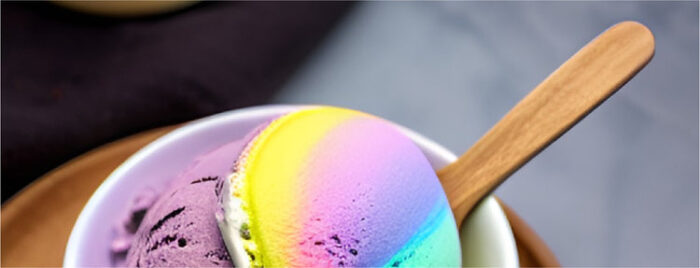
For The Scent of it Lovin’ Spoonful splash page
One thing that has always intrigued me when smelling fruit notes and ingredients is how they all remind us of the flavors we find in juice, candy and even ice cream. For good reason. Most of the same ingredients are used by flavorists. This is a point I wanted to touch on my new summer gourmand at For the Scent of It, Lovin’ Spoonful. I wanted this perfume to take people back to childhood with the tart, fruity cream of rainbow sherbet. That mouthwatering, summer staple that melted into our hands as well as our hearts. I chose to do a twist on the classic flavors by using lemon, kumquat, kaffir lime and raspberry. The fruity smell and taste of rainbow sherbet has been in my memory since the 90’s, and I wanted to capture that memory in a bottle. Without the tart, red fruitiness of raspberry, that would not have been possible.
These are just a few of the fantasy fruit notes found in the fruit bowl and only a handful of ingredients capable of replicating them in perfumery. There’s no end to the imagination. There is no end to the fantasy.
–Michael Schrammel of For the Scent of It Perfumes and Contributor
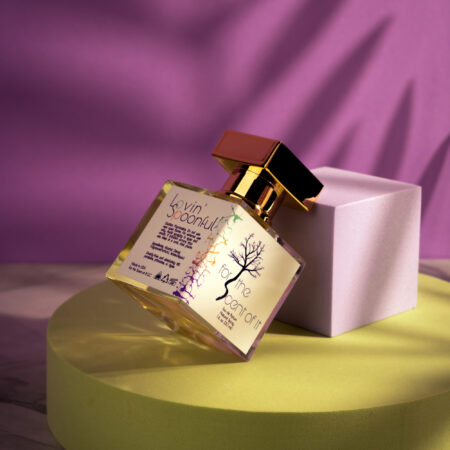
Lovin’ Spoonful, For the Scent of It
As a thank you for enjoying Michael’s Notes from the Lab on Fantasy Fruit Notes, For the Scent of It will be offering a 30ml bottle of Lovin’ Spoonful to one registered reader un the Please register here or your comment will not count. To be entered, in the comments section below, describe which fruit notes in perfumery are your favorite. The winner will be randomly chosen and must reside in the USA or Canada. Draw closes 6/30/2023
Lovin’ Spoonful Notes: Lemon, Kumquat, Kaffir Lime, Raspberry, Iris, Jasmine Sambac, Lavender Ice Cream, Vanilla, Musk, Vetiver, White Cedar

Michael Schrammel courtesy of the perfumer
Michael is the owner, perfumer and everything in between at For the Scent of It perfumes. His persistence, creativity, and desire to create an atmosphere drive his fragrance development. Self-trained, Michael started studying the art of perfumery in 2015 before launching For the Scent of It perfumes in 2021.
Read his Profile in American Perfumery here
Please like The Series on Facebook here and your comment will count twice.
PLEASE VISIT FOR THE SCENT OF IT Online Shop AND SUPPORT OUR ARTISAN PERFUMERS
Enjoy Michael’s Notes From The Lab” Fantasy Floral Notes”
All photos are owned by For the Scent of It perfumes, unless otherwise stated.
Follow us on Instagram @cafleurebonofficial @forthescentofit
This is our Privacy and Draw Rules Policy
